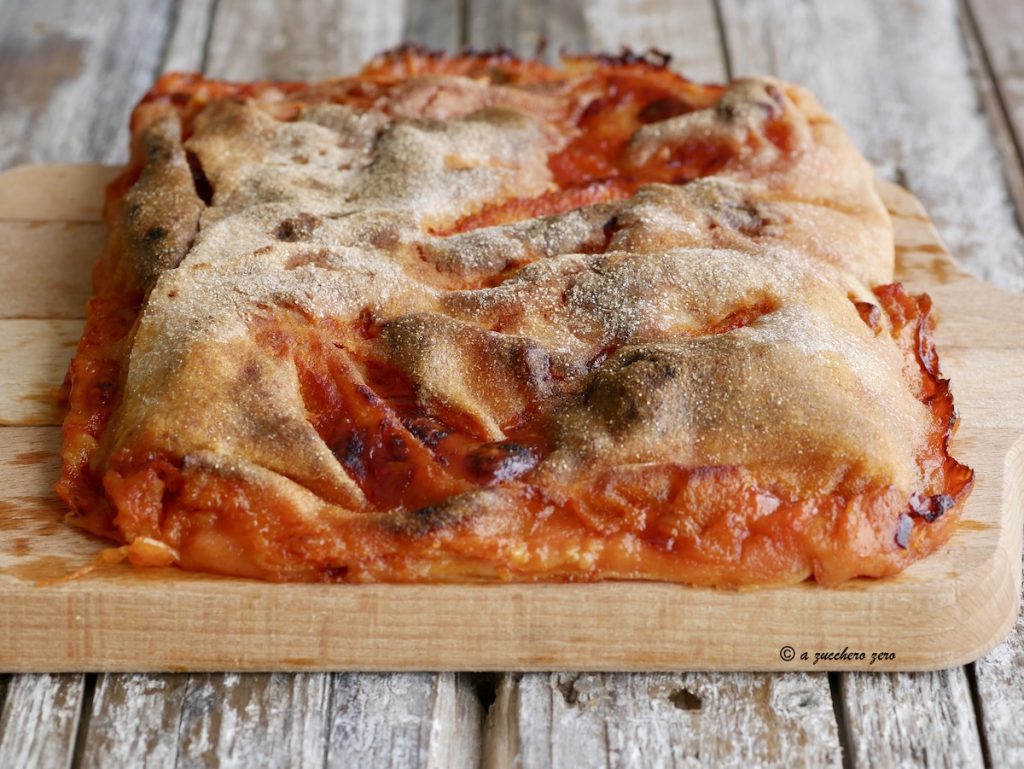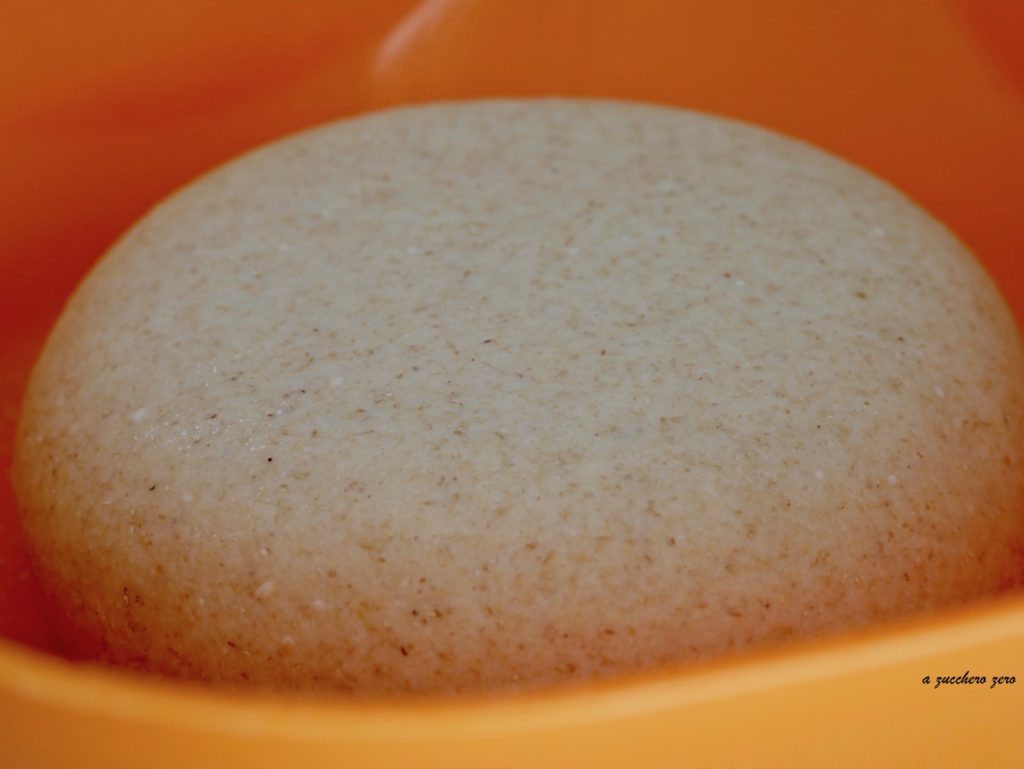The traditional Ragusan scacce dough is based on re-milled semolina flour.
I prepared my Ragusan scacce dough with stone-ground whole semolina.
Ragusan scacce semolina dough
Whether using semolina or whole semolina, the recipe’s quantities and procedure are identical.
The whole wheat dough is slightly more delicate to handle and roll out, so if you’re a beginner, I recommend using re-milled semolina flour.
Ragusan scacce dough yeast
As for the yeast, some add it and some don’t.
Personally, I prefer to prepare my Ragusan scacce dough with yeast [1 g and slow rise].
I use a basic mixer but you can easily knead by hand.
In any case, the secret is to achieve an elastic and firm dough and then roll out the dough as thinly as possible.
The Ragusan scaccia is a dish from the gastronomic tradition of the province of Ragusa, Sicily.
There are numerous types in terms of shape and filling.
In the scaccia ragusana fuogghi fuogghi the dough is rolled very thin with a rolling pin, stuffed and rolled or folded onto itself.
In the scaccia ragusana ‘mpanata the dough is rolled thicker, stuffed, and closed like a round savory pie or a half-moon calzone with a meticulous decoration called riefico.
Dialectal and local curiosities
The scaccia with vegetables is variably known from Ragusa to Modica and the surrounding areas as:
– scaccia;
– pastizzu if round-shaped;
– buccatieddu if half-moon shaped.
I will tell you how to make Ragusan scacce dough step by step.

- Difficulty: Easy
- Cost: Economical
- Rest time: 1 Day
- Preparation time: 20 Minutes
- Cuisine: Italian
Ingredients
The whole wheat dough is slightly more delicate to handle and roll out.
If you’re a beginner, I recommend using re-milled semolina flour.
- 500 cups re-milled semolina flour (or whole wheat)
- 1.25 cups water (slightly sparkling)
- 0.04 oz dry yeast (Mastro Fornaio PANEANGELI)
- 0.5 tsp extra virgin olive oil
- 0.5 tsp salt
- 1 kg cups re-milled semolina flour (or whole wheat)
- 2.5 cups water (slightly sparkling)
- 0.04 oz dry yeast (Mastro Fornaio PANEANGELI)
- 1 tsp extra virgin olive oil
- 1 tsp salt
As an alternative to dry yeast you can use:
• 0.1 oz of fresh yeast;
• 0.14 oz of dried mother dough.
* 0.25 oz of dry yeast corresponds to 0.88 oz of fresh yeast, check the manufacturer’s instructions.
Suggested Tools
I use a basic mixer but you can easily knead by hand.
- Food Scale
- Mixer with hook attachment
- Bowl for rising with lid
- Cutting Board pastry board
Preparation
Warm the water: it should be lukewarm, not hot.
Pour the lukewarm water into a jug, add and dissolve the yeast.Pour into the mixer bowl:
– the semolina or whole semolina;
– the oil;
and start the mixer at speed 1.Continue processing at speed 2 for about 10 minutes:
– adding the water in which you dissolved the yeast a little at a time;
– adding the salt halfway through the process to avoid direct contact with the yeast.
* varying the type of semolina/flour can slightly alter the amount of water required, remember that the dough should always be elastic and firm.
At the end of the 10 minutes of processing, the bowl will be perfectly clean, and you will have an elastic and firm dough that is easy to work with.Transfer the dough onto a cutting board or a pastry board and knead it briefly by hand to form a dough ball.
Dust the bottom of a bowl with semolina and place the dough ball inside.
Seal the bowl with a lid or wrap it with cling film.
Store it in a cool and dark place.AFTER 4 HOURS
After about 4 hours, turn the dough ball out onto a lightly floured cutting board or pastry board with a bit of semolina.
Knead it a few minutes by hand and shape it back into a dough ball.
Place it back in the bowl, seal it, and store it in the same place.24 HOURS LATER
After about 24 hours – more or less the same time as you kneaded the day before – turn the risen dough ball out onto a lightly floured cutting board or pastry board with a bit of semolina.
* after 24 hours the dough ball should be doubled or almost;
the rise depends on various factors such as flour, yeast, and environmental conditions.
Knead the dough a few minutes by hand to restore elasticity and shape it back into a dough ball.Your traditional or whole wheat Ragusan scacce dough is ready to be used in the preparation of Ragusan scaccia.

To discover the different variations of scaccia and impanata, you can use the blog’s “search” function by typing “scaccia” or “impanata” or consult the collection by clicking on the following link: Ragusan scacce recipes.
Variations
Scacce ragusane dough recipe without yeast
You can prepare your scacce ragusane dough without yeast and shorten the preparation times:
– do not add yeast;
– add a pinch of baking soda.
Knead and let the dough rest at room temperature for about an hour.
After an hour at room temperature, your dough without yeast is ready to use.
A versatile dough for savory and sweet pastries
The dough for Ragusan scacce with or without yeast is a versatile dough perfect for making savory rustic pastries filled with various shapes and fillings: calzones and turnovers, pinwheels and rolls, pies and savory tarts.
Additionally, sweet rustic pastries such as: cassatelle, turnovers and ravioli, pinwheels and rolls, pies and strudels.
FAQ (Questions and Answers)
Ragusan scacce semolina dough
The traditional Ragusan scacce dough is prepared with re-milled semolina flour.
The semolina generally has a good glycemic response, but whole semolina is the recommended choice for those desiring a dough with a low glycemic index.
To learn more about this topic, you can click on the following link: Semolina and flours glycemic index type 2 diabetes.Ragusan scacce dough yeast
As for the yeast, some add it and some don’t.
Personally, I prefer to prepare my Ragusan scacce dough with yeast.
You can prepare your Ragusan scacce dough without yeast and shorten the preparation times.
The dough with yeast results in a softer texture.Doses for different types of yeast
I used 0.04 oz of dry yeast [up to 2.2 lbs of semolina/flour].
Alternatively, you can use:
• 0.1 oz of fresh yeast;
• 0.14 oz of dried mother dough.
* 0.25 oz of dry yeast corresponds to 0.88 oz of fresh yeast, check the manufacturer’s instructions.Why sparkling water in the dough?
Sparkling water helps to make the dough lighter and fluffier.
You can still use regular water.If dough is left over
– you can use it to make delicious flatbreads or light whole wheat flatbreads;
– you can freeze it, making sure to take it out of the freezer the night before using it.

